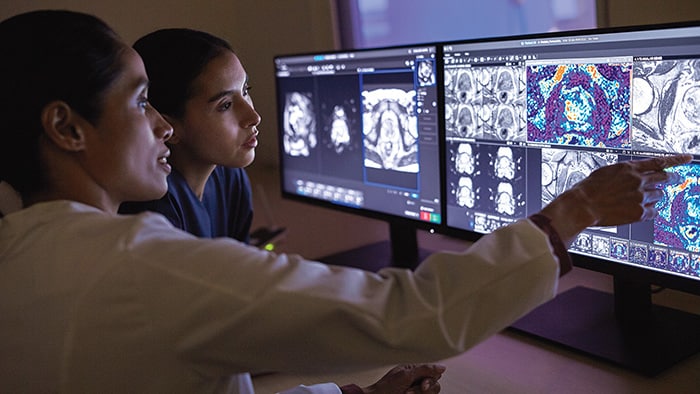Like all commercial enterprises, healthcare organizations need to make a return on their investments. In recent years, we’ve seen how data has helped them achieve this by revealing costly inefficiencies and broken processes. But while many providers have seen success here, few have been able to tap into the vast potential that a special kind of ROI – return on insights – can offer when it’s done at scale. But what does it mean to go beyond data and harness the power of insights at scale, and what new returns can healthcare leaders expect to generate?
Data vs insight: what’s the difference?
Before we talk about what it means to have insights at scale, let’s clarify what I mean by ‘insight’.
Imagine a 54-year-old patient, Lucas. Which of the following would help you improve quality of care, reduce cost of care, and enhance his experience as a patient?
The first statement certainly seems like a useful piece of data – an elevated blood-sugar. Though, what value does it provide beyond that? We’re left wondering if this is a fasting blood sugar value, or perhaps this is post-meal in which case it may be acceptable. More critically, as a single data point it offers no trend information. If we had a string of data points revealing an upward trend, then we may have concluded Lucas has diabetes. The point is that data – while necessary – may not be sufficient to guide us to delivering on the quadruple aim.
Now let’s consider the second statement. This is an insight, a red flag that intervention is necessary to help alter the predicted course of his diabetes. Some may refer to this as “clinical prediction” which is based upon machine learning applied to Lucas’ prior medical data. Whatever terminology you choose, the outcome is that you have gained an insight about his likely clinical course. This insight can now help you plan treatment interventions to improve outcomes and reduce overall cost of care.
With this example, I trust the difference between data and insights has become clearer: the former is an atomic element that requires context for interpretation, whereas the latter provides a deeper understanding of the patient’s likely clinical course (an insight) and helps you manage the patient’s treatment plan. Plus, if you look carefully, there is a subtle point in the example I shared: the insight was generated by machine learning. As clinicians, we could not have reasonably reviewed all the prior clinical data in the chart at the moment of care and come up with that insight. However, a computer can “read” through the chart at machine-speed and surface an insight for you just when you need it – at the point of care.
This is why, between the two choices above, I would prefer the machine-generated insight, and I would like that level of insight at-scale in any patient I see.
The compounding value of insights at scale
Now imagine if your healthcare organization had on-demand access to these sorts of insights in every part of your business, in both clinical and operational settings. Seamless, reliable data exchange between patient and practitioner, and across every device, generates informative, actionable insights embedded in your workflow, providing operational forecasting, clinical prediction, and enhancing the patient experience. While one of your teams may be using insights to determine the optimal treatment path for coronary artery disease, another may be using insights to automate reports for your billing and inventory management. Serving your organization from end to end, these insights change the very fabric of your business and how you operate for the better. This is what we mean when we talk about organizations having insights at scale – and this is what I’m passionate about enabling for today’s ambitious healthcare leaders.

For the purposes of this post, we won’t dive into the weeds of insights-at-scale infrastructure – more on that in a future post. Instead, let’s focus on what I find most exciting about insights at scale: benefits healthcare leaders should embrace because of the compounding value that they can generate.
Let’s look at an example. Nearly every ambulatory care clinic has to navigate the delicate balance between variable-length appointment times, late arrivals, last-minute bookings, no-shows and staff absenteeism. Managing these variables manually is inefficient, costly and a burden on your teams. So you invest in a digital solution – an AI system that analyzes data on your patients and assigns a no-show prediction to each of them. The system has just returned the following insight: “Sara has an 80% no-show likelihood for her next appointment.” While that insight is simple and self-explanatory, there is a compounding value it can generate for your organization:
Consider where we started (with a single operational insight) versus where we’ve ended up: that isolated 80% prediction unlocked a broader set of value; this is your Return on Insights. This is the power of insights at scale: it’s not always about having a large number of atomic insights – it’s about the second-order effects generated by those insights, leading to high-value, far-reaching returns across your organization.

To put these compounding returns in a real-world context, we recently collaborated with West Moreton Hospital in Australia, which was looking for a way to reduce in-hospital COVID-19 transmissions and the associated burden on their teams. We developed a remote-care solution where patients were given tablets and medical devices to measure and report just three values: temperature, blood pressure and oxygen levels. The data generated was then fed into an integrated telemonitoring platform that returned insights on likely patient deteriorations – prompting clinicians to intervene earlier, or start dialogues with the most at-risk patients, increasing patients’ ability to self-care from home. The insights generated resulted in a 53% reduction in emergency department visits, savings of AUD 1,010 per patient per month, and a 28% decrease in potentially preventable hospitalizations in chronically ill patients – all while simplifying the clinician experience and handing more independence back to patients. Once again, we see how even a relatively low insight ‘set’ can generate a multitude of high-value returns.
How to get started on the road to insights at scale
Embracing insights at scale doesn’t have to mean applying AI or predictive analytics capabilities to every single part of your business. Nor does it require dealing with a deluge of insights from the get-go. You’d be surprised by how much value you can generate by starting with a few select use cases (like in the example of our no-show patient, Sara). Typically, I suggest beginning with use cases in operational forecasting, because clinical predictions are naturally more complex and tend to involve much more varied data types. Moreover, most organizations find it simpler to embed operational insights into their existing workflows. Once you’ve seen those early insights translate into measurable outcomes, I suggest expanding further into clinical domains. Ultimately of course, the goal is to get to a place where your organization can make a return on insights in all areas, so you can improve the patient experience, streamline the staff experience, lower the cost of care, and improve your patients’ health outcomes, delivering on the Quadruple Aim. If you’re ready to set out on this journey with your organization, then let’s collaborate – I’d love nothing more than to help you start generating return on insights. For more information on Philips’ award-winning solutions and full portfolio of connected informatics solutions being showcased at the HIMSS22 Global Health Conference & Exhibition, please visit www.philips.com/himss and follow @PhilipsLiveFrom for #HIMSS22 updates throughout the event.
Share on social media
Topics
Author

Shez Partovi
Chief Innovation & Strategy Officer and Business Leader of Enterprise Informatics, Royal Philips Shez Partovi obtained his medical degree from the McGill University, in Montreal, Canada and completed his neuroradiology subspecialty at Barrow Neurological Institute in Phoenix, AZ. He is a serial entrepreneur and has launched several health IT companies, including two on telehealth.
Click here to read more on Shez Partovi
Follow me on













